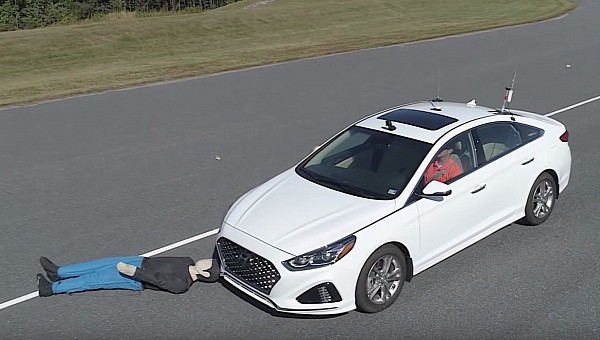Back in March 2016, the U.S. Department of Transportation and Insurance Institute for Highway Safety convinced no fewer than 20 automakers to make automatic emergency braking standard in this part of the world.
In no particular order, these automakers are Tesla, Volkswagen, Nissan, Porsche, Toyota, Volvo, Subaru, Mitsubishi, Kia, Mazda, Jaguar Land Rover, Hyundai, Maserati, General Motors, Mercedes-Benz, Audi, Honda, Ford, BMW, and FCA US LLC (a.k.a. Stellantis after the merger with Groupe PSA).
They pledged to equip at least 95 percent of their light-duty cars, crossovers, and trucks with crash avoidance technology by the end of 2022, and thus far, 15 automakers have fulfilled this incredibly ambitious commitment.
The latest automakers to join the 95-percent club are Stellantis, Mitsubishi, and Nissan (including Infiniti). The remaining 12 that had passed the 95-percent mark early are Honda (including Acura), Ford (including Lincoln), BMW, Audi, Hyundai (including Genesis), Toyota (including Lexus), Volkswagen, Mercedes-Benz, Subaru, Mazda, Tesla, and Volvo. Kia narrowly missed the cut, increasing the percentage of AEB-equipped cars from 89 percent back in 2021 to 94 percent at the moment of writing.
“The overwhelming number of vehicles produced with this critical safety technology means that consumers will receive safety benefits even if they aren’t actively shopping for them,” said Jennifer Stockburger, director of operations at CR’s testing center. “Additional capabilities that many of these systems also provide, such as pedestrian detection and the ability to function at highway speeds, have the potential to save even more lives."
Automakers who could’ve done better include Porsche (70 percent), Maserati (71), General Motors (73), and Jaguar Land Rover (75). By 2025, the Insurance Institute for Highway Safety expects the voluntary commitment to prevent 42,000 crashes and 20,000 injuries in the U.S. of A.
The AEB systems on current-generation vehicles have to meet certain performance criteria. For example, the Insurance Institute for Highway Safety requires at least an advanced rating in the vehicle-to-vehicle front crash prevention test. To earn this rating, the system must slow the vehicle by at least 10 miles per hour (16 kilometers per hour) in either the 12- or 25-mph (19- or 40-kph) tests or by 5 mph (8 kph) in both evaluations.
They pledged to equip at least 95 percent of their light-duty cars, crossovers, and trucks with crash avoidance technology by the end of 2022, and thus far, 15 automakers have fulfilled this incredibly ambitious commitment.
The latest automakers to join the 95-percent club are Stellantis, Mitsubishi, and Nissan (including Infiniti). The remaining 12 that had passed the 95-percent mark early are Honda (including Acura), Ford (including Lincoln), BMW, Audi, Hyundai (including Genesis), Toyota (including Lexus), Volkswagen, Mercedes-Benz, Subaru, Mazda, Tesla, and Volvo. Kia narrowly missed the cut, increasing the percentage of AEB-equipped cars from 89 percent back in 2021 to 94 percent at the moment of writing.
“The overwhelming number of vehicles produced with this critical safety technology means that consumers will receive safety benefits even if they aren’t actively shopping for them,” said Jennifer Stockburger, director of operations at CR’s testing center. “Additional capabilities that many of these systems also provide, such as pedestrian detection and the ability to function at highway speeds, have the potential to save even more lives."
Automakers who could’ve done better include Porsche (70 percent), Maserati (71), General Motors (73), and Jaguar Land Rover (75). By 2025, the Insurance Institute for Highway Safety expects the voluntary commitment to prevent 42,000 crashes and 20,000 injuries in the U.S. of A.
The AEB systems on current-generation vehicles have to meet certain performance criteria. For example, the Insurance Institute for Highway Safety requires at least an advanced rating in the vehicle-to-vehicle front crash prevention test. To earn this rating, the system must slow the vehicle by at least 10 miles per hour (16 kilometers per hour) in either the 12- or 25-mph (19- or 40-kph) tests or by 5 mph (8 kph) in both evaluations.
A total of 20 automakers entered the historic 2016 commitment aimed at getting the highly-effective technology into vehicles more quickly than through regulation.
— IIHS (@IIHS_autosafety) December 8, 2022
Full update from IIHS and @ConsumerReports: https://t.co/A58pAAgclB pic.twitter.com/w1Gr7xCMPj











